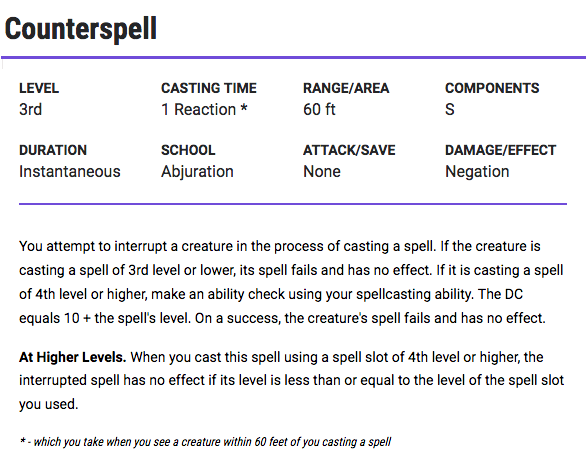Counterspell is a spell you cast as a reaction to stop another spell:

Xanathar’s Guide to Everything (XGE) introduced an optional rule for identifying a spell. It also costs a reaction:

This creates a tension between identifying a spell and deciding to counter it. You can only spend your reaction on one. The grand implication is that you don’t know what spell you’re trying to counter!
Without that information, counterspell becomes a lot less useful.
Informational Advantage
Like our last discussion about Cutting Words, this doesn’t really mesh with the way we play the game. Typically, a DM or player announces that a character is casting the spell by naming the spell. If a DM or player announces their spell while the opposing side holds a counterspell, they’re technically putting themselves at an informational disadvantage.
This information matters in the case of counterspell, because it’s only guaranteed to work if you cast it at the same level as the spell you’re trying to stop. Which is different than the issue with Cutting Words. With Cutting Words, the lack of information goads you into wasting a feature. With counterspell, you aren’t at risk of wasting the spell. It might not shut down the spell you want. It might require a roll instead of working automatically. But you’re going to get some benefit.
So, there is value in keeping the mystery around counterspell. But, is it worth the disjointed presentation of announcing you’re casting a spell and waiting for reactions before leaning into the fiction? Is that even necessary to comply with the Rules as Written (RAW)? And can we tidy these mechanics by compressing them? Let’s dive in.
Mechanics First
One school of thought says you don’t need to worry about this. The rules work fine.
Mechanically, the spell identification rule is just a reaction tax on the party. Another member of the party can identify the spell and tell the spellcaster what it is, granting them the information to decide whether the counterspell.

Narratively, this is hard to jive. How does all that happen in the split-second timing of a reaction? Is it really more realistic for someone else to tell the counterspeller the type of spell they’re trying to counter? Shouldn’t the person shutting down the spell have the best idea of what it is they’re trying to stop? Wouldn’t someone who identified a spell be in a better position to stop it?
Narrative First
Alternatively, there is a way to run Counterspell by RAW without ignoring the narrative implications of delegating spell identification.
Lean into the narrative.
The dark mage scrapes dusty black crumbs off the floor of the cave, using both hands to roll it into tiny, glowing ball that expands in flames at she launches it towards you, shouting “Enflamante!”
Make a Dexterity save.
This example is especially deliberate, but it’s meant to be illustrative. By describing the casting, we telegraph information about the spell to the players without giving up the name. Reward players for paying attention. Here’s some things you can lean into when describing spellcasting:
- Material components
- Verbal components
- Somatic components
- Colors (by school as defined by detect magic)
- Elements (fire, cold, lightning, acid, etc.)
- Shape (ray, cone, spray, cube, dome)
- Type of saving throw or attack roll
You can punctuate this type of narrative by calling for a saving throw or announcing that you’re making an attack. Technically, this is giving away more information about the spell than the rules probably intend you to, but it can be rewarding for players who know their spellbook. Consider the amount of information you disclose to be a dial that you can tune to your table.
The saavy caster will be able to use this information to determine whether it’s worth using counterspell. Or, they can use their reaction to identify the spell, which can assist them in the future if they’re holding a counterspell and they encounter the same description. And that’s good! Players should be using information available to their characters.
Nested Reactions
Of course, if you’re still not satisfied with the anticipatory pause, we can hack the mechanics a little bit. Just cram everything into the same reaction. If the player uses the optional rule from XGE to identify the spell, and they succeed in doing so, let them cast counterspell as a part of the same reaction.
Big thanks to all our supporters on the ThinkDM Patreon. Mark Poole’s counterspell Magic: the Gathering card art adorns this article, as permitted by the Wizards Fan Content Policy.
In our game we work it like this:
“If you spend your Reaction to identify the spell, you can AS PART OF THE SAME REACTION cast Counterspell. You can also choose *not* to cast Counterspell. Either way, your Reaction is spent.”
This allows you to gather information about the spell before you potentially “waste” the Counterspell, but it still commits you to the course of action. You’re primed and ready to Counterspell, but you can “pull back” if you want. You have already “flinched”, though, and can’t take that back.
LikeLiked by 1 person
Reblogged this on DDOCentral.
LikeLike